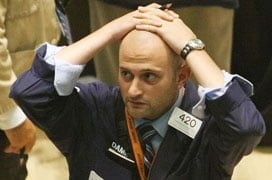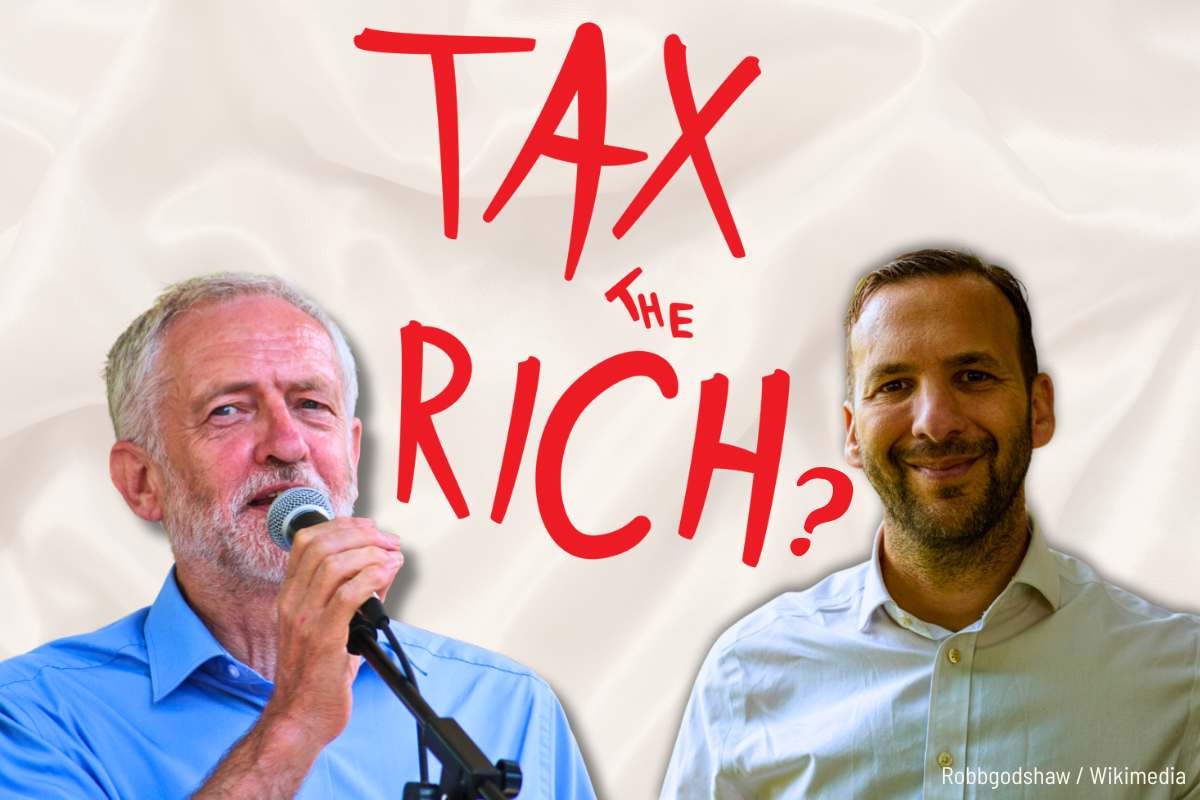As I write, world stock markets are still reeling from yet another shock to the
system brought on by the so-called credit crunch that has enveloped capitalist
financial markets since last summer.
The latest shock was the biggest yet. Late on Sunday night, 16 March, the US
Federal Reserve Bank announced that Bear Stearns, America’s fifth-largest investment
bank, was bust. So it had agreed that JP Morgan-Chase, an even bigger bank, would
take over Bear Stearns. JP Morgan was to pay just $2 a share and it would not be
paying cash, but just offering JP Morgan shares to Bear Stearns shareholders. At
the same time, the huge loans and bonds of $30bn that Bear Stearns had on its books
would be guaranteed by a loan from the Federal Reserve to JP Morgan.
In effect, JP Morgan was getting Bear Stearns and its business for virtually
nothing. It was paying $256m (and not in cash) for a bank that had buildings alone
worth $2bn and whose shares were worth over $100 each just a few months ago! And
the risky loans that Bear Stearns had, and which had forced it to the wall, were
going to be guaranteed by the Fed. What a deal for JP Morgan!
The US state authorities were doing this because they knew that Bear Stearns could
not meet its obligations to other banks and creditors. It had run out of cash and
nobody in Wall Street, New York’s financial centre, would lend to it. If it went
bust, however, then all the other banks in Wall Street and in Europe too would incur
huge losses on their loans and contracts to Bear Stearns and perhaps force some of
them into bankruptcy too.
The Fed had to act in bailing out the great capitalist financial system. So it has
taken on a considerable obligation to the rest of the banking system on behalf of
the taxpayer – that’s us.
The Fed’s action echoes what happened with Northern Rock in Britain. There a
medium-sized mortgage lender that had pretensions to become a bigger bank went bust
when it could not borrow enough money to pay interest or principal to the banks and
investors who had bought its mortgages.
In this case, the Bank of England refused an offer from Lloyds Bank to buy Northern
Rock for a pittance with guarantees on its loans, like the Fed did with JP Morgan to
buy Bear Stearns. Instead, it opted to try and save the bank by providing taxpayer
funds directly.
The Bank of England’s plan did not work and it racked up huge obligations – nearly
$100bn compared to $30bn the Fed just provided. Eventually, the government was
forced to nationalise NR with the aim of sacking most of the workforce and selling
off much of the mortgages to get our money back.
Whatever the solution opted for by the state monetary authorities in the US or the
UK, it shows that the credit crunch has reached such proportions that large banks
are now going to the wall. No wonder former Fed Chairman Greenspan called the
global financial crisis the worst since the 1930s. The financial sector of
capitalism is tottering.
How did it get into this sorry state? The key to understanding the crisis is the
changing relationship between the productive and unproductive sectors of capitalism.
Capitalism is a system of production of things that people need for profit.
Production is not for need, but for profit. If there is no profit, there is no
production even if people need things or services.
By that definition, the productive sectors of capitalism are those that generate
profit. Marx explained that only labour can generate value and profit arises when
the value of goods or services sold on the market exceeds the cost of employing
labour and investing in plant and raw materials to make goods or services.
But some sectors of capitalism may seem to make a profit, but in reality are really
just extracting or redistributing profits actually generated in other sectors of the
economy. Thus, real estate companies can make a profit on buying and selling
properties and on the fees they charge. But nothing has been produced in that
process. Profits are also made when private builders build a house and sell it.
But here something that people need is produced. From the point of view of
capitalism, the productive sector is house-building but the unproductive sector is
real estate, because that is where the profit that real estate agents make is
originally generated.
For capitalism, the productive sectors that generate profit are broadly
manufacturing, mining, transport and communications. But these sectors must buy the
services of lawyers, estate agents, advertisers and above all they must borrow from
the banks and financial institutions to finance investment and pay their employees.
These sectors are necessary to lubricate the wheels of capitalism, but they are
unproductive because they do not generate profits for the whole economy, but merely
get a bite out of the revenues produced by the productive sectors.
Just as ‘necessary’ and unproductive for capitalism are the government sectors of
health, education, police and the armed forces. They are necessary to preserve the
health and skills of the workforce and keep ‘law and order’. But they do not
generate surplus-value or make a profit in themselves.
What has happened over the last 25 years particularly has been a massive expansion
of the unproductive sectors of the capitalist economy (at least in the mature
advanced capitalist economies of North America, Western Europe and Japan). As
capitalism has matured it has become increasingly less oriented to production. The
shrinking productive sectors have had to finance an ever-growing unproductive sector
or mature capitalist economies have had to extract profits from the fast-rising
productive sectors in China, India and Latin America.
As a result, economic growth in the mature economies has slowed to a trickle
compared to the golden decades of the 1950s and 1960s. Sure, economic growth has
not been as convulsive and volatile as in the 1970s, but it has averaged no more
than 3% a year in the advanced economies compare to 5-6% in the post 1948 period.
That’s because more and more investment has been diverted into unproductive sectors
that have given only the appearance of better profitability. And worse, as
profitability declined in productive sectors, the monetary authorities tried to
boost growth by lowering interest rates and printing more money. Money capital
grew, giving the appearance that there was plenty of capital or profit to reinvest.
But as Marx would say, this was fictitious capital. It was not real because it was
not based on profits made in the productive sectors of capitalism, but merely the
result of the printing of paper money, or the making of contracts for bonds,
mortgages and other financial instruments. In the last 15 years, completely new and
ever more exotic financial instruments were created to finance the buying of stocks
and shares, buildings and homes and even some investment in real production.
This fictitious capital reached astronomical levels. The world’s annual output was
worth about $53 trillion in 2007. However, bank loans reached $40 trillion, the
stock markets of the world reached $50trn, the bond and mortgage markets reached
$70trn and most astounding of all the derivative markets (contracts to buy or sell
bonds, stocks or loans by a certain date) reached $500 trillion, or ten times world
GDP!
Clearly, world capitalism had become unreal. This could not last. The trigger was
housing. This, after all, was one the biggest parts of fictitious capital. Cheap
mortgages and a huge influx of money enabled even average earners to get onto the
housing market from about 15 years ago. Everywhere the housing market took off:
rising prices bred even bigger mortgages and even higher prices. The appearance of
prosperity led homeowners to borrow money on their houses and spend like there was
no tomorrow.
And the banks not only provided ever more mortgages to people who could not afford
them; they also sold on those mortgages as bonds to other banks and investors greedy
for the higher interest and prices that they earned.
Then about mid-2005 American house prices began to stop rising so fast and even
started to fall. Prices had got so high that more and more people could not afford
to buy, even with cheap and easy mortgages.
The productive sectors of the economy
were just not generating enough wage increases and profit rises to pay for high
house prices. Just as the stock market bubble had burst in 2000, leading to
economic recession in 2001, now it was the turn of the housing market bubble.
House prices in the US have now slumped over 10%, with falls as big as 30% in key
states like California and Florida. People began to default on their mortgages.
Banks that held them were forced to write off these debts. But many of these
mortgages had been packaged off as bonds to others. Investors now found that their
bonds were worthless. They had borrowed on the value of these bonds and now could
not pay back their creditors. Soon the credit crunch was swinging right through the
financial sectors of America, Europe and Asia. Eventually we have come to Bear
Stearns.
When banks have to pay losses with their shareholders money, they are forced to find
more investors or they must cut back on lending. That’s because they cannot lend
more than say ten times the value of their investor’s capital or the deposits they
hold. Most of the time, investors and depositors don’t want their money all once,
so banks ‘leverage’ up, assuming that they only need to pay out on about 10% of
their liabilities at any time.
So if their capital disappears as they pay off losses and if depositors all demand
their money back at once, they face bankruptcy. So they must be careful and cut
back on their lending or go bust like Bear Stearns. So they must deleverage.
Banks and other financial institutions are now deleveraging like mad. They won’t
lend to home owners or manufacturers, or they will lend less and at higher interest
rates. Fictitious capital is disappearing and the poor state of real capital is
being revealed beneath a welter of worthless paper.
This spells economic slump. As I have argued in this column many times, capitalist
profitability goes up and down in cycles according to Marx’s law of the tendency of
the rate of profit to decline. This is a tendency: profitability does not always
decline. Indeed, in the US, the UK and Europe, it rose from 1982 to 1997. But now
we are in the middle of the down phase in profitability that is likely to last until
2013-15.
In the down phase, falling profitability can sometimes lead to an actual fall in the
mass of profits generated by capitalism producing a bout of economic recession where
production slows, unemployment rises and investment falls until profitability is
restored.
This process is now happening. US corporate profits are now falling and soon
European corporate profits will too. Then investment will slow or stop and
unemployment, which has been falling in the US and Europe since 2002, will start to
rise – and fast.
The last economic recession was in 2001 and it was very mild because, although
profits fell, the huge boost of fictitious capital into the housing market kept up
consumer spending. Now we are entering an economic recession when housing markets
everywhere are heading downwards and credit has dried up. This is going to be the
worst economic downturn for
capitalism since 1991 or 1981, maybe as bad as 1974-5.






